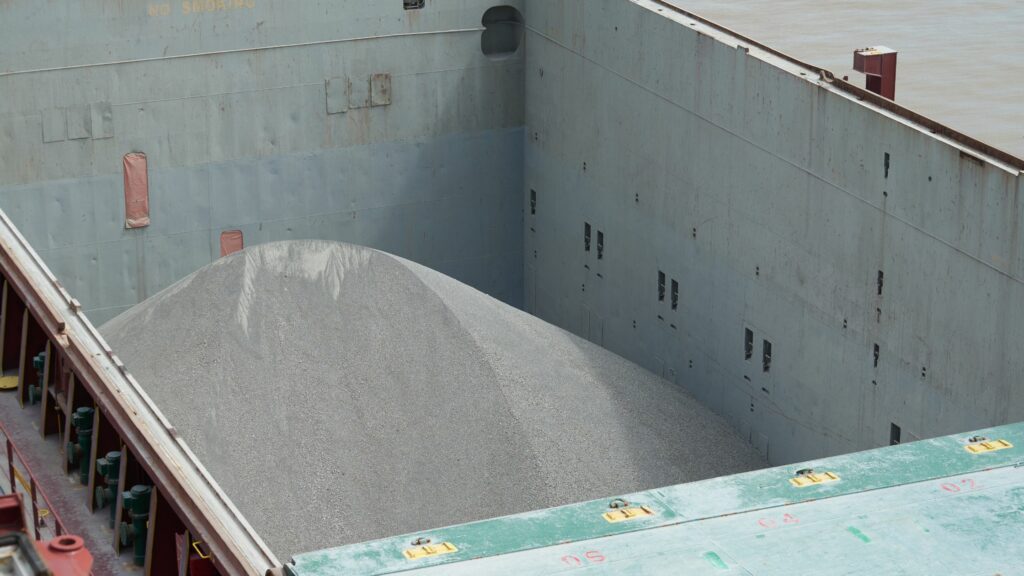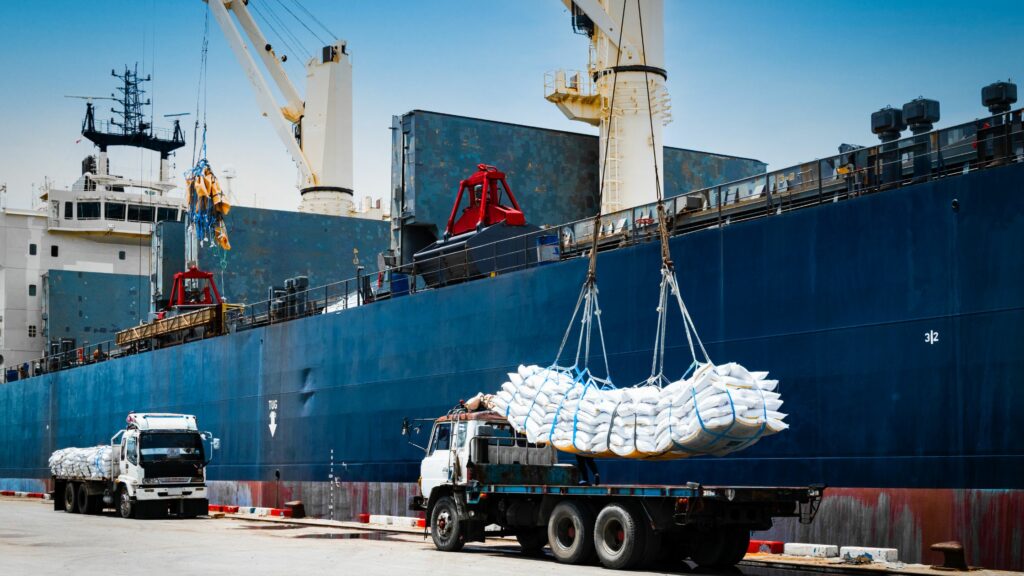Physical Address
304 North Cardinal St.
Dorchester Center, MA 02124
Dry bulk shipping is the workhorse of global trade. It moves the essential raw materials – think iron ore, coal, grains – that power industries, build cities, and feed populations worldwide. Without these specialized ships constantly crossing the oceans, the supply chains we depend on would simply break down.
This part of the shipping world is huge. Industry analysts estimate dry bulk accounts for over 40% of all goods moved by sea volume-wise, easily billions of tonnes each year. It directly supports steelmaking (which needs iron ore and coking coal), energy generation (thermal coal), construction (cement, aggregates), and agriculture (grains, fertilizers). Even things like making appliances or getting electricity often start with materials moved on a bulk carrier.
Compared to container shipping, which moves finished goods in boxes, dry bulk often gets less attention. It deals with unpackaged raw materials further up the supply chain. Still, its health is closely tied to the global economy. When industries boom, demand for raw materials rises, and so does demand for bulk carriers. That’s why metrics like the Baltic Dry Index (BDI), published daily by the Baltic Exchange, are watched so closely – they give a real sense of global industrial activity based on the demand to ship these basic materials. Big swings in the BDI can signal shifts in the wider economy.
Dry bulk cargo is any solid, unpackaged commodity shipped in large amounts. The cargo is loaded loose into a ship’s holds. Usually, it’s a raw material like ore or grain, or an intermediate product like clinker, heading for further processing.
These cargoes are measured by weight, using deadweight tonnage (DWT), which is the total carrying capacity of the ship. Common dry bulk cargoes include:
The process covers the whole journey: from the mine, farm, or factory, onto the bulk carrier, across the sea, and finally unloaded at the destination port. It needs specialized ships with big holds and hatches, plus ports with the right gear for loading and unloading efficiently.
It’s different from container shipping (using standard boxes) and tanker shipping (for liquids like oil or chemicals). Bulk carriers typically haul one type of cargo per trip. The network isn’t based on fixed schedules like container lines; it’s more like a global taxi service for commodities, responding to supply and demand shifts. Routes depend on trade needs, port limits (like water depth), and what makes sense financially for shipowners and the companies chartering the ships (charterers). Tracking ship movements using AIS data helps understand these fluid patterns.
This sector is the pipeline for materials essential to major industries:
Shipping in bulk saves money through economies of scale, helping keep commodity prices reasonable. It also avoids lots of packaging. But, disruptions – a blocked canal like Suez or Panama, port backlogs, or political issues – can cause serious delays and cost increases across industries. Trade in essential goods like grain and coal is also sensitive to politics, trade policies, and conflicts, as recent events have shown.
To operate in this market, you need to know the language – the cargoes, the ships, the ports, and the contracts.
Dry bulk cargoes generally fall into two groups, a classification often used by market analysts like Clarksons or Drewry:

Handling requires care. Grains can spoil or shift in transit. Coal can create dust or even combust spontaneously. Scrap metal might pose fire or injury risks. Food-grade items, particularly grains, require meticulously prepared holds. Achieving what’s known in the trade as ‘grain clean‘ standard means holds must be completely free of residues from previous cargoes, rust, pests, or other contaminants to prevent spoiling the shipment. This often requires thorough cleaning and inspection before loading. Because spills go straight into the sea, safety and environmental rules are strict. The IMO’s IMSBC Code (International Maritime Solid Bulk Cargoes Code) sets standards for safe handling and transport, and groups like INTERCARGO promote best practices.
This major/minor bulk split shapes the whole business – the ship types needed, the port equipment required (like specific grab types or shiploader capacities), and the common shipping routes.
Bulk carriers or bulkers are built specifically for this job. Their size is measured in DWT (deadweight tonnage). Size dictates cargo capacity, fuel efficiency, which routes and canals they can use, and which ports they can fit into (based on water depth, berth size, etc.). Maritime data firms like Clarksons track these details closely.
Ships can be ‘gearless‘ (need shore cranes) or ‘geared‘ (have their own cranes, useful for basic ports). There are also specialized types like self-unloaders (with built-in conveyor belts), Lakers (for the Great Lakes), and rarer OBOs (Ore/Bulk/Oil carriers).
Here are the main classes, from smallest to largest:
Moving bulk cargo efficiently requires specialized port terminals. Export terminals focus on loading ships fast; import terminals focus on discharging them.
Key gear includes:
Storage options:
Ports choose between high-capacity fixed systems (expensive but efficient for major bulk terminals) and flexible mobile equipment (lower initial cost, adaptable, good for minor bulks or multi-use berths).
Dry bulk follows major sea lanes connecting producing regions to consuming centers. Examples:
These routes often pass through narrow maritime chokepoints:
Choosing a route involves balancing vessel size, distance, transit time, fuel costs, canal fees, weather, and freight rates. Chokepoints save time and money but are vulnerable. A closure forces ships onto longer, costlier routes, tightening vessel supply and raising transport costs globally.
Dry bulk freight rates – the price to ship cargo – are determined by the volatile interplay of supply (available ships) and demand (cargo needing transport).
Main drivers:
The Baltic Dry Index (BDI) from the Baltic Exchange tracks the overall market. It’s a weighted average of daily rates for standard Capesize, Panamax, and Supramax timecharter routes. Because it reflects demand for basic industrial raw materials right at the start of the supply chain, the BDI is seen as a good indicator of global economic health. It’s considered fairly ‘pure’ because it’s tied closely to actual physical cargo movements, not just financial speculation (though an FFA market does exist).
Port time for loading or unloading, critical for voyage economics, is managed through specific charter party clauses like laytime, demurrage, and despatch, often based on standard BIMCO forms:
How laytime counts depends on the contract wording: ‘Running Days’ (counts continuously), ‘Working Days’ (excludes weekends/holidays), ‘Weather Working Days’ (pauses for bad weather), ‘SHEX’ (Sundays/Holidays Excepted). Laytime can also be ‘Reversible’ (time saved at one port can be used at the other) or ‘Non-reversible’ (each port’s time is separate).

These terms allocate the risk of delay. Owners risk voyage delays (e.g., weather at sea); charterers risk delays during cargo operations. Negotiating laytime allowances and demurrage/despatch rates is a key part of chartering. Disputes are common, making clear contract language essential.
This industry is fundamental, but it’s facing big changes. Environmental rules from the IMO (like EEXI and CII targets for ship efficiency and carbon intensity) and regions like the EU are pushing hard for lower emissions (CO2, SOx, NOx) and cleaner ballast water management. This demands big spending on new tech: alternative fuels (LNG, methanol, ammonia), energy-saving devices, better ship designs, and smarter operations.
Technology is also changing things. Digital tools help with voyage planning, tracking ship performance, and seeing the supply chain more clearly. Automation in ports and maybe even on ships (autonomous vessels) is being explored.
Global trade itself keeps shifting – driven by economic changes, new resource finds, different consumer habits (like less coal use for power), and political shifts. The world’s bulker fleet is also getting older. Replacing old ships with modern, efficient, compliant ones is a tough decision given market uncertainty and high building costs. Recent low levels of new ship orders and scrapping, often highlighted by analysts like Drewry or Clarksons, might signal caution but could lead to tight ship supply if demand picks up strongly.
So, the dry bulk sector has to keep moving the world’s essential stuff while also transforming itself. That means investing smartly in sustainable tech, adapting to digital tools, and managing the usual market swings and political risks. How well it handles these challenges will shape its future – and the future of global supply chains.
For reliable data, analysis, and news on dry bulk shipping, these organizations and outlets are good places to look:
Dry bulk shipping is the transport of unpackaged commodities like iron ore, coal, and grains in specialized vessels. It accounts for over 40% of global seaborne trade by volume and uses ships designed with large hatches and holds. Cargo is loaded loose, and operations resemble a “taxi service” rather than fixed schedules.
Dry bulk shipping supports global trade by moving billions of tons of essential raw materials annually. It underpins industries like steel, energy, construction, and agriculture, reduces per-ton costs, equalizes global commodity prices, and serves as an economic indicator through the Baltic Dry Index (BDI).
The main types of dry bulk carriers are Handysize, Handymax/Supramax, Panamax, Capesize, and VLOC/Valemax. These ships vary by size and cargo capacity, with Handysize handling minor bulks and VLOCs carrying massive iron ore loads on long-haul routes requiring specialized ports.
Seasonal factors affect dry bulk shipping by influencing cargo volumes, routes, and port operations. Harvest seasons boost grain shipments, winters increase coal transport for heating, and monsoon or hurricane seasons disrupt logistics. Rates like the Baltic Dry Index and demurrage costs often fluctuate seasonally.
The dry bulk shipping industry faces challenges including environmental regulations, market volatility, technological transitions, evolving trade patterns, and infrastructure constraints. Issues like carbon pricing, overcapacity cycles, fuel transition costs, port congestion, and shifting global demand require strategic adaptation.